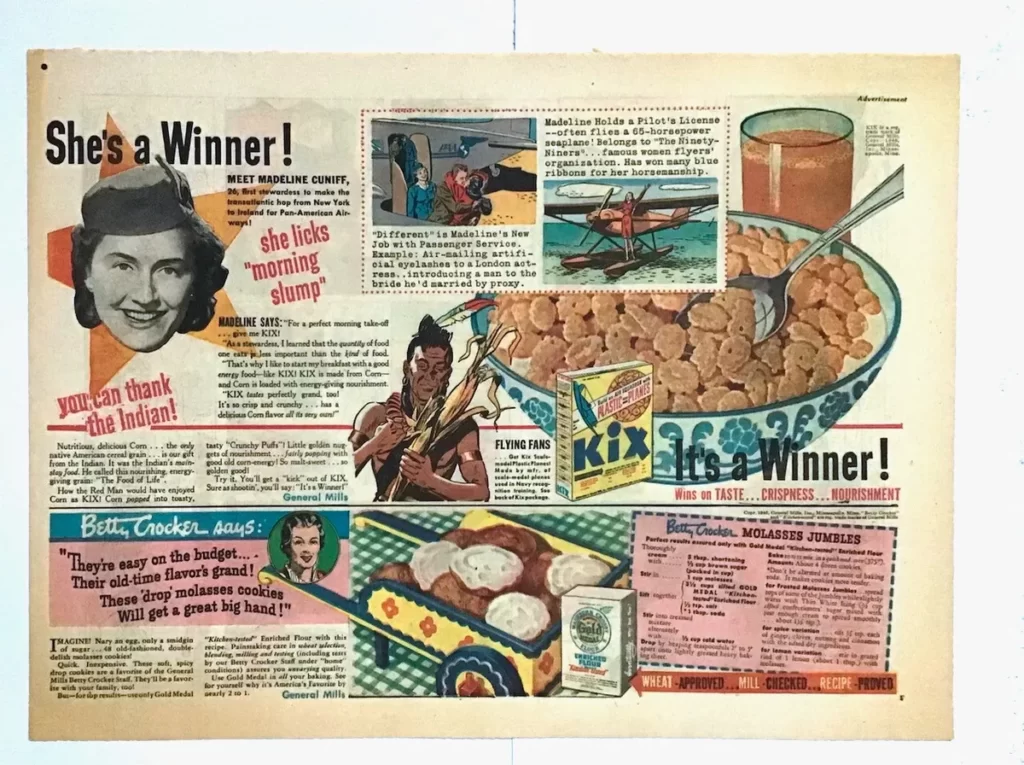What is Traditional Advertising?
Traditional advertising refers to any form of promotion or marketing that utilizes long-standing offline mediums. This encompasses everything from print ads in newspapers and magazines to commercials on radio and television. Additional examples include:
- Billboards
- Flyers
- Direct mail
- Telemarketing
- Event sponsorships
- Product placement
- Public relations
In the past, these tactics formed the core of significant advertising campaigns for brands and businesses. They allowed companies to broadcast messages to vast swaths of their target audience through mediums like primetime TV ads.
However, over the last 20 years, the advertising industry has shifted rapidly alongside advancing digital technology. Internet marketing, social media ads, and online content now receive the most attention and budget.

But while the focus has shifted to digital, traditional advertising remains integral to the marketing mix. Tried and true formats help today’s brands connect with broad audiences to build awareness. When combined strategically with digital, they can bolster results across online and offline channels.
Key Takeaways
- Traditional advertising, like print, radio, and TV ads, is still effective for building brand awareness and reaching broad audiences.
- Tactics like billboards, direct mail, and event sponsorships excel at specific goals like local engagement.
- Combining traditional ads with digital tactics makes the most of different formats and audiences.
- Think through campaign objectives and target demographics instead of defaulting to the latest social media trends.
- Test and track results to double down on what works and shift unsuccessful attempts.
Advantages of Traditional Advertising
Brand building: Television, radio, and print ads excel at plastering a brand’s name and messaging across mediums with widespread use. This blanketing effect works to etch the brand into the audience’s memories. The same big-budget TV commercial repeatedly plants that brand message into viewers’ minds.
Broad reach: Traditional advertising mediums tend to reach a more comprehensive portion of the general population than targeted digital ads. Billboards on highways, commercials on national TV stations, and newspaper ads get seen by large, undefined audiences within a local area.
Trust and authority: Consumers tend to trust information more when delivered through long-standing outlets they recognize. A radio ad, quality print magazine, newspaper, or TV commercial may capture more initial belief than an equivalent digital ad.
Local targeting: Strategies like event sponsorships, billboards, and radio effectively target geographically defined areas. These formats work to embed brands into local communities.
Awareness driver: Brand recall lifts higher with traditional ads compared to digital, according to Nielsen. Television, radio, and print better cement brand awareness, especially with sustained use.
Disadvantages of Traditional Advertising
Less targeting: Broad-reaching traditional formats lack precision compared to digital ads tailored using data, tracking pixels, and algorithmic optimization—a television commercial targets primarily by geography and broad demographics. Digital ads deploy much more granular targeting.
More challenging tracking: Determining exact ROI poses more difficulty with traditional tactics where causality proves harder to track. Digital marketing data clearly shows volumes of clicks, actions, conversions, and attributed sales from each ad impression. Physical formats only offer proxy brand lift metrics or inferred success.
Higher cost: Big-budget TV ads, national newspaper campaigns, and mass direct mailing require significant upfront outlays and offer difficulty adjusting spending. They generally carry higher minimums while lacking the ability to pause or adapt.
Ad avoidance: Technology like DVR and streaming circumvent television ads while the readership of print newspapers declines over time. This avoids eyeballs, which could instead view digital video ads that are not skippable on YouTube or social feeds.
Less flexibility: Unchanging printed ads get locked in based on distant deadlines, while radio and TV slots are booked far in advance. Limited ability to pivot separates them from adaptable digital campaigns.
Still Relevant in a Digital Age?
Given the rise of digital, social media, and internet marketing, some question whether traditional advertising retains relevance. Traditional mediums seem less prevalent, with so many consumers plugged into smartphones, actively using social platforms, and binge-watching streaming television.
Countless blogs and thought leaders have written the obituary of old-school marketing tactics. But frequently, these volumes get published too soon. Various innovative technologies like radio, television, and the internet were initially forecasted to drive their predecessors into extinction.
Yet previous mediums stubbornly persist. Each continues finding an audience, if smaller than before. Traditional advertising follows the same path – while no longer retaining exclusive dominance, it stubbornly persists even in today’s digital world.
There remain good reasons to continue using traditional advertising:
Reach: Television, radio, and print advertising maintain huge audiences, still outpacing even the most prominent digital platforms. Over 90% of US adults watch television, and a majority listen to radio every week.
Familiarity: Audiences know and trust messages delivered through long, familiar, traditional formats. They encounter billboards, hear radio ads, and flip through print magazines without blocking ads. This familiarity delivers higher initial trust.
Brand building: Consistent use of traditional advertising generates increased brand awareness and recall. It builds mental availability by splashing logos, slogans, and products where audiences repeatedly encounter them.
Local targeting: Strategically placed billboards, local event sponsorships, and niche print publications effectively target audiences in specific geographic areas. This works for regional businesses targeting a local area.
All ages: While older demographics skew towards traditional mediums, these formats remain vital for reaching wide age ranges. Only a tiny fraction of seniors and middle-aged groups rely exclusively on digital devices without TV or radio.
Campaign diversity: Varied options allow for building an “omnichannel” campaign incorporating the strengths of different formats. Television, print, and online ads combine to reach consumers whether they browse digitally or through traditional outlets.
Still, Use Traditional Tactics Sparingly
Despite defending traditional advertising’s ongoing role, exclusively relying on these tactics no longer makes much sense given today’s diffused media options. Most brands should strategically integrate traditional options as only part of their overall marketing.
Younger audiences AND increasing portions of older groups now rely primarily on digital devices, streaming television, and social feeds as their primary media inputs. These consumers become more challenging to reach through traditional outlets alone.
Plus, offline campaigns suffer from measurement difficulties with fuzzy attribution of how each medium drives brand lift and sales. Online digital tracking precisely follows users across devices to optimize spending.
Thus, brands should adopt traditional advertising judiciously based on campaign goals and target audience:
- What specific objectives do you want to achieve? Pure brand awareness? Local sales? Website traffic? These goals help select appropriate mediums.
- Who comprises your target demographic, and where do they regularly receive information? Understand your audience’s media habits before choosing advertising formats.
- Consider blending traditional options with online, digital, and social ads for broader, measurable reach. These combined tactics integrate into an effective omni-channel campaign.
- Limit traditional spending to smaller tested budgets until you verify positive ROI based on website traffic, online leads, phone calls, coupon redemptions, or other tractable results.
- Don’t assume traditional tactics’ reputation or familiarity today retains the same resonance. Continually re-evaluate messaging against the preferences of younger consumers.

Traditional Advertising Campaign Examples
Let’s explore some real-world examples where brands successfully leveraged traditional advertising:
M&M’s Times Square New Year’s Eve Sponsorship
- Objective: Increase brand awareness and positive brand sentiment
- Strategy: Sponsor the iconic New Year’s event in Times Square for seven years straight
- Tactics:
- Prime logo placement in live TV footage seen by over 1 billion viewers
- Brand ambassador appearances
- wraps on public transit displaying branding
- Shared #RealMoments hashtag and user-generated content
- Results:
- Over 7 billion media impressions
- Hundreds of millions of social media impressions
- Substantial uplift in brand love and purchase intent
Pepsi’s Super Bowl Halftime Show Sponsorship
- Objective: Generate interest and conversation as a younger-focused brand
- Strategy: Align with one of the most significant live television events – the Super Bowl
- Tactics:
- Become the lead sponsor of the Super Bowl halftime show
- Produce dazzling headliner performer shows for five straight years
- Conduct user-generated content campaigns for the halftime show
- Purchase television ads during the Super Bowl
- Results:
- Over 110 million live viewers for the sponsored shows
- Ranked #1 Advertiser driving purchase intent
- Become strongly associated with music and pop culture for younger consumers
Singapore Tourism Board Print Magazine Ads
- Objective: Drive travel bookings to Singapore from Australia
- Strategy: Place beautiful, stylish print ads in Australian magazines
- Tactics:
- Bright vivid imagery and bold colors catching user attention
- Focus messaging on dining, luxury shopping, and attractions
- Target Australian fashion, travel, and lifestyle magazine
- Time ads to coincide with periods when more users are planning vacations
- Results:
- Increase referrals from Australian travel agents by over 25%
- Magazine readers who recalled seeing ads 87% more likely to visit
- Click through rates of 4-6% from ads to tourism site
Alaska Airlines LA Sponsorship Campaign
- Objective: Grow brand awareness and preference in Los Angeles
- Strategy: Embed into Los Angeles local fabric as a proud community sponsor
- Tactics:
- Sponsor the new LA football stadium and dub “Alaska Airlines Field at L.A. Memorial Coliseum”
- Have naming rights at the Los Angeles Zoo as the “Alaska Airlines LA Zoo”
- Sponsor food trucks around Los Angeles serving Alaska signature dishes
- Television and outdoor ads conveying Alaska’s LA local pride
- Results:
- Unaided brand awareness increase double digits in Los Angeles
- Become 2nd most popular airline for LA airport travelers
- Higher than normal mileage plan sign ups from Los Angeles residents
Key Traditional Advertising Mediums
Now let’s explore popular specific traditional mediums leveraged by savvy marketers and the advantages of each:
Television Advertising
Television ads take the form of commercials inserted into programming content. They generate impressions from large audiences in a passive relaxed mode open to influence.
Benefits
- Broad demographic reach including hard-to-find audiences
- Drive brand awareness and positive brand perception
- Perceived as more authoritative by consumers
- Creative formats like demonstrations capture user attention
Considerations
- High cost for airtime and producing quality commercials
- Viewership declining year over year as audiences shift online
- Short shelf life as popularity of TV shows fluctuates
Radio Advertisements
Like television, audio ads get woven into regular radio programming. Listeners tuned into music, talk shows, sports and news absorb embedded promotions.
Benefits
- Geographic targeting to metro areas and regions
- Captures listeners during frequent daily commute times
- Low production costs and affordable compared to other mediums
Considerations
- Creative restrictions of audio-only format
- Listenership shifting to digital streaming music platforms
- Lower impact due to passive listening multi-tasking
Newspaper Advertisements
Ads placements embedded among newspaper articles and content capture reader’s attention during deep information absorption.

Benefits
- Targets relevant niche readers by paper type/geography
- Perception as trusted news source transfers to ads
- Long shelf life and “coffee table” reshare effect
Considerations
- Declining newspaper readership as users shift online
- Limited local reach for smaller regional papers
- Poor reproduction quality degrades images and creative
Magazine Advertisements
Advertisements get prominently placed within popular magazine issues on topics like lifestyle, fashion, sports which have avid readership appeal because of high quality photographs and design spreads.
Benefits
- Captures readers during immersive content consumption
- Perceived authority transfers to placed promotions
- Targets specific lifestyle segment niches
Considerations
- High competition from competing ads
- Short shelf life of relevance as new issues replace old
- Production lead times require planning non-adaptive campaigns
Out-of-home Advertising
Out-of-home advertising umbrella captures outdoor signage formats like billboards, public transit ads, posters and placards in high traffic areas allowing constant impressions against local pedestrians and motorists.
Benefits
- Flexible geographic targeting by placement
- Difficult to ignore during daily commutes
- Constant impressions cement brand familiarity
Considerations
- Limited demographics indication beyond geography
- Difficult to track exact consumer actions based on ads
- City sign ordinances may restrict use
Direct Mail Marketing
Direct mail campaigns deliver brand promotions like postcards, catalogs and newsletters directly to target user mailboxes rather than shared public channels.
Benefits
- Granular demographic and geographic targeting
- Trackable calls-to-action like discounts to calculate ROI
- Perceived as personalized connection
Considerations
- Manual addressing increases costs
- Clutter mixes with regular unwanted mail items
- Strict data guidelines on purchased lists
FAQ
Q: Doesn’t traditional advertising pale against the tracking and optimization of digital campaigns?
In some ways, yes. Lack of precise measurement hampers tweaking traditional efforts. Yet classic formats remain effective for overall brand lift which indirectly boosts conversion metrics. Smartest strategy combines tradition and digital together based on strengths.
Q: Aren’t the prime days of traditional advertising back in the Mad Men era long gone?
While past decades saw greater dominance by pure traditional campaigns, these mediums retain sizable audiences. Television, newspapers and radio all still reach 50-75% or more of consumers weekly, numbers most digital platforms still work towards.
Q: Doesn’t younger demographic completely ignore traditional formats for Snapchat and TikTok?
There exists a perception of a wide generation gap but numbers say otherwise. Over 90% of teenagers and 20-somethings still watch television shows and YouTube videos featuring consistent ads. Other traditional exposures reach large percentages as well.
Q: Should smaller businesses with limited budgets bother with expensive traditional formats?
Less costly local variations help small companies. Strategically placed billboards, local radio spots, and community event sponsorships effectively promote locally. Combined with low-cost digital these make affordable integrated local marketing.
Q: How do you accurately calculate the ROI of a traditional advertising campaign?
Determining direct causative return proves difficult outside digital’s precise user tracking. Marketers should set brand lift surveys, unique call tracking numbers, vanity URLS, or offer codes to help quantify responses to traditional ads. Regardless, some attribution requires reasonable guessing.
Q: We have an extremely targeted customer niche. Are traditional tactics just wasted spend for us?
Possibly, but not necessarily. Consider a multi-channel campaign where traditional options like print trade journals or sponsoring niche industry events create awareness while tailored digital reaches those most likely to convert. Comprehensive campaigns integrate various formats.
Q: Does investing more money in big budget traditional buys like Times Square billboards directly translate to better results?
Bigger spends grab attention but not always efficient results. Diminishing returns set in beyond minimum needed for awareness. Smartest advertisers focus on strategic placement and message testing over budget size in order to generate ROI. Creative, targeting and bid adjustments outweigh spending.
Q: Can you truly integrate traditional tactics seamlessly with advanced digital when they seem years behind?
It simply becomes necessary in today’s complex media landscape. Set common campaign branding, messaging and offers across traditional and digital channels. Use offline media to drive traffic online for conversion there. This integrated methodology builds on the strengths of distinct formats.
Q: We have always advertised in newspapers. Can we just shift those exact ads to digital instead since that is where everyone is now?
Not quite. Message adaptation works better driving engagement and conversions on digital channels. Consider adjusting length, design, content and calls to action to optimize based on what performs online. Test new variants against old layouts and continue refining the winning digital recipe.




Leave a Reply